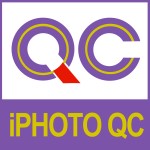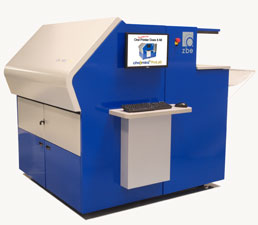|
Q: What are the biggest advantages of the Chromira SE Lab?
A. The SE Lab ensures high productivity, cost savings, broad versatility, and high efficiency workflow and easy integration.
Q. What is “high productivity”?
A.: SE owners realize:
- Proven operational and energy savings
- Simple operation
- High volume print production
- Use of available labor to sort and cut prints and assemble order packages
- Easy integration with workflows
- Perfectly color matched prints
- Affordable pricing
- Very low maintenance costs
Q. What cost savings will I see?
A. Chromira SE labs experience:
- Operational and energy savings
- Effective labor utilization where resources are available and/or comprise a relatively small portion of operational expense.
Q. What is “broad versatility?”
A. SE Lab owners achieve:
- Small footprint for placement almost anywhere with no darkroom
- Perfectly color matching at all print sizes
- Beautiful digital images from 2-up wallets up to 30” x 164 feet from one roll of 30’ media
- Images on all RA4 surfaces, including backlit display films
- Enables imagers to participate in multiple market segments with a more diverse, relevant and exciting portfolio
Q. What is a “high efficiency workflow and easy integration?”
A. Experience:
- Flawless integration with all popular workflows
- Streamlines workflow for maximum savings in energy, space usage, equipment and maintenance
- Uses available lab labor in sorting and cutting prints and assembling packages
- Reduces the turn-around time in opening new market opportunities
Q: Will the Chromira SE Lab workflow integrate with other digital workflow software?
A: The SE Lab was designed to seamlessly integrate with all popular workflow applications to meet your digital production and workflow. They include: Fuji PIC, Kodak DP2, Express Digital, ROES, Labtricity, Frontline, Workstream, etc.
Q. What kind of files can the Chromira SE Lab print?
A: The Chromira SE Lab will print RGB TIFF, JPEG and BMP files. TIFF files may be either PC or MAC type. Other file types (such as Postscript) must first be converted to TIFF in order to be printed on the Chromira Se Lab. Postscript files are converted to TIFF files with a Raster Image Processor (“RIP”).
Q: What size prints can the Chromira SE Lab make?
A: The Chromira SE Lab can make prints of any size up to 30” (76cm) wide by 160 (48.8m) feet long. There is no minimum size restriction.
Q: Does the Chromira SE Lab cut prints to size?
A: Yes, depending on the length of your roll and the size of your print. The Chromira SE Lab cuts prints across the width of the paper. If you have a 20” roll and are cutting 20”x30” prints, they will be cut to size. If you are producing smaller prints, they will need to be trimmed.
Q: What size paper does the Chromira SE Lab take?
A: The SE Lab now supports print roll widths from 30” (76cm) down to 10” (25.5cm).
Q: How does Chromira SE Lab handle color matching between multiple size prints?
A: Since all prints come from the same roll, they are automatically color matched.
Q: How do prints come out of the machine?
A: Prints are deposited on the “print deck”.
Q: Can the Chromira SE Lab be upgraded to cut, sort, and collate?
A: Yes. The SE Lab is fully upgradeable to obtain the cutting, sorting, and collating benefits of the Chromira 5x ProLab. These automatic capabilities will result in an enhanced workflow significantly improving turn-around, accuracy, and delivery.
Q. Will an upgraded Chromira SE Lab be as good as a ProLab?
A: Yes. When you upgrade your Chromira SE Lab to full ProLab capabilities, it will be to include all the workflow advantages of the Chromira ProLab.
Q: Does Chromira SE Lab require a darkroom?
A: There is absolutely no darkroom required. Other “daylight” operation machines require a darkroom in order to load “daylight” paper cassettes. Mini-lab type machines can use a changing bag on a separate table instead of a darkroom, but large-format machines all need a darkroom. Not only is this inconvenient, but it doubles the amount of space needed for the machine. In order to avoid the use of a darkroom, the Chromira SE Lab omits the use of a cassette. Chromira SE Lab uses the original paper box as its cassette. The whole box goes into the machine and the operator loads the machine by reaching through a light-tight panel. This takes about 30 seconds. No darkroom. No cassette. No cassette to drop and break. The Chromira SE Lab is a true daylight operating printer.
Q: How big is the Chromira SE Lab?
A: The footprint of the Chromira SE Lab is 5’ x 5.5’ (1.5m x 1.7m), smaller than many mini-labs.
Q: Does the Chromira SE Lab include or require a “Front End”?
A: The usual “Front End” bottleneck is eliminated with Chromira SE Lab. Each PC networked in the Lab has full access to the “front end” functions. This completely eliminates the need for a dedicated “front end” computer, and removes the bottleneck, which results from having to pass each print job through the “front end” workstation. There is no such thing as “pre-processing time” with the Chromira SE Lab.
Q: Does the Chromira SE Lab require a dedicated operator?
A: Yes, the Chromira SE Lab is a working machine that is constantly outputting prints. An operator will be required to empty the collating trays and print catcher (for large prints).
Q: What about a RIP?
A: Most digital imaging departments have one or more RIP packages they use to drive other printers. Since Chromira SE Lab is an “open system”, it works with any RIP that can generate an RGB TIFF file (including most popular RIPs). The Chromira SE Lab should integrate easily into any system.
Q: How does the Chromira SE Lab connect to our computer(s) or workstation(s)?
A: Chromira SE Lab does not plug in like a desktop printer. It has a built-in Windows XP computer and connects to the other computer(s) over the network much like any other PC. Files can travel over the network to the Chromira SE Lab as it is printing. Everything necessary to the interface to the network is included with the Chromira SE Lab. The user need only supply the network connection to plug into it.
Q: Since the Chromira SE Lab is PC-based, how can I print images from my MAC?
A: The Chromira SE Lab can print RGB TIFF files in both MAC and PC formats. MAC images can be brought to the Chromira SE Lab via 1) Network, 2) Disk, or 3) CD.
Q: How fast does Chromira SE Lab print?
A: Chromira SE Lab prints at 24 (61 cm) inches per minute. That equals:
- 1440 4x6” prints per hour
- 8x10 prints per hour
- 11x14 prints per hour
- 20 x 30 prints per hour
- 30x40 prints per hour
Q: What materials can the Chromira SE Lab print on?
A: Chromira SE Lab prints on virtually all RA4 photographic material. This includes paper and display films. It prints beautifully on digital B&W, Kodak Metallic and Fuji Pearl.
Q: Does the Chromira ProLab function emulsion in or emulsion out?
A: Chromira ProLab can be set to print with either an emulsion in or emulsion out setting, depending on the user's preference.
Q: Does the Chromira SE Lab backprint?
A: No, the Chromira SE Lab does not include backprinting. However, backprinting is one of the benefits you gain when you upgrade to the full Chromira 5x ProLab.
Q: What kind of RA4 chemistry does the Chromira SE Lab use?
A: Chromira SE Lab can utilize any brand of standard RA4 photographic chemicals.
Q: Will the Chromira SE Lab work in a location that does not have a floor drain?
A: Yes, the Chromira SE Lab can be configured to utilize “washless RA4” chemistry when convenient floor drain is not available.
Q: What are the benefits of running Chromira SE Lab as a washless printer?
A: The most important benefit is that Chromira SE Lab can operate in virtually any location where power, water, and air are available.
Q: Who manufacturers the RA4 processing module of the Chromira SE Lab?
A: The RA4 processing module of the Chromira SE Lab is engineered and manufactured by Engineering Services to ZBE’s specifications.
Q: How is the Chromira SE Lab calibrated?
A: Primary calibration of the Chromira SE Lab is done by printing a test image. The calibration image has a series of gray patches ranging from white to black. The gray patches are read with a densitometer that connects into the computer. The Chromira SE Lab calibrates automatically from these densitometer readings. The process is generally called “linearizing” the machine.
Q: How does color management work on the Chromira SE Lab?
A: Color management on the Chromira SE Lab works by applying a “profile” on-the-fly to the image being printed. The purpose of the profile is to make adjustments to the colors as specified in the image file so that colors of the print will match the colors of the original. In practice, color profiles will also adjust the color differences between brands of paper. It will be necessary to have a different profile for each brand and type of paper being printed. The profile is applied on-the-fly to the image file during rasterization.
Q: Can I adjust the color of an image when I print it?
A: Yes.
Q: How does the Chromira SE Lab’s resolution compare with the resolution of an inkjet printer?
A: Images printed on the Chromira SE Lab are far superior in image quality to images from an ink jet printer. The resolution of the Chromira SE Lab is specified in continuous tone Pixels per Inch. Inkjet printers specify resolution in Dots (of ink) Per Inch. It is generally considered that it takes 5-6 times the resolution in Dots per inch to match continuous tone resolution. Thus it would take an ink jet printer at least 1500 Dots per Inch of resolution to equal the quality of the Chromira SE Lab’s prints at 300 Pixels per Inch.
Q: In the event of a technical problem, what service support is there to help me?
A: ZBE provides telephone, web and onsite support dependent on your need. Technicians are available by telephone from 7:30 am to 6:00 pm, Pacific Time.
ZBE has an innovative software tool, “Chromira Expert Tech”, to minimize customer downtime. Its breakthrough diagnostics capabilities, technical support and reporting capabilities significantly speed and enhance troubleshooting. When an error is reported to ZBE’s Web Service Portal, the “Chromira Expert Tech” software collects critical customer experience information, including calibration, balance and usage. It prompts the Printer Operator to answer specific clarifying questions. This information is automatically analyzed by diagnostic software tools to identify the issue and prospective causes. The data and analysis is evaluated by ZBE Service Professionals for further testing and verification. “Chromira Expert Tech” saves customers time spent in collecting data and answering questions. The Lab’s downtime is greatly reduced through enhanced problem solving and fast response.
If ZBE Service and you determine that a technician is needed on sight, ZBE will make arrangements for a trained, contracted technician in your area to respond within 24 hours.
|





